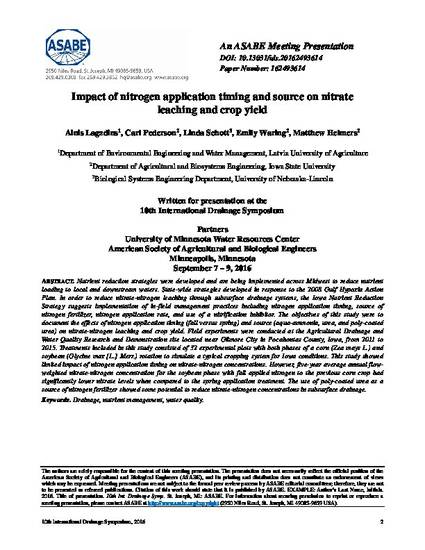
Nutrient reduction strategies were developed and are being implemented across Midwest to reduce nutrient loading to local and downstream waters. State-wide strategies developed in response to the 2008 Gulf Hypoxia Action Plan. In order to reduce nitrate-nitrogen leaching through subsurface drainage systems, the Iowa Nutrient Reduction Strategy suggests implementation of in-field management practices including nitrogen application timing, source of nitrogen fertilizer, nitrogen application rate, and use of a nitrification inhibitor. The objectives of this study were to document the effects of nitrogen application timing (fall versus spring) and source (aqua-ammonia, urea, and poly-coated urea) on nitrate-nitrogen leaching and crop yield. Field experiments were conducted at the Agricultural Drainage and Water Quality Research and Demonstration site located near Gilmore City in Pocahontas County, Iowa, from 2011 to 2015. Treatments included in this study consisted of 32 experimental plots with both phases of a corn (Zea mays L.) and soybean (Glycine max [L.] Merr.) rotation to simulate a typical cropping system for Iowa conditions. This study showed limited impact of nitrogen application timing on nitrate-nitrogen concentrations. However, five-year average annual flow-weighted nitrate-nitrogen concentration for the soybean phase with fall applied nitrogen to the previous corn crop had significantly lower nitrate levels when compared to the spring application treatment. The use of poly-coated urea as a source of nitrogen fertilizer showed some potential to reduce nitrate-nitrogen concentrations in subsurface drainage.
Available at: http://works.bepress.com/matthew_helmers/154/

This paper is from International Drainage Symposium, Paper No. 162493614, pages 1-6 (doi: 10.13031/IDS.20162493614). St. Joseph, Mich.: ASABE.